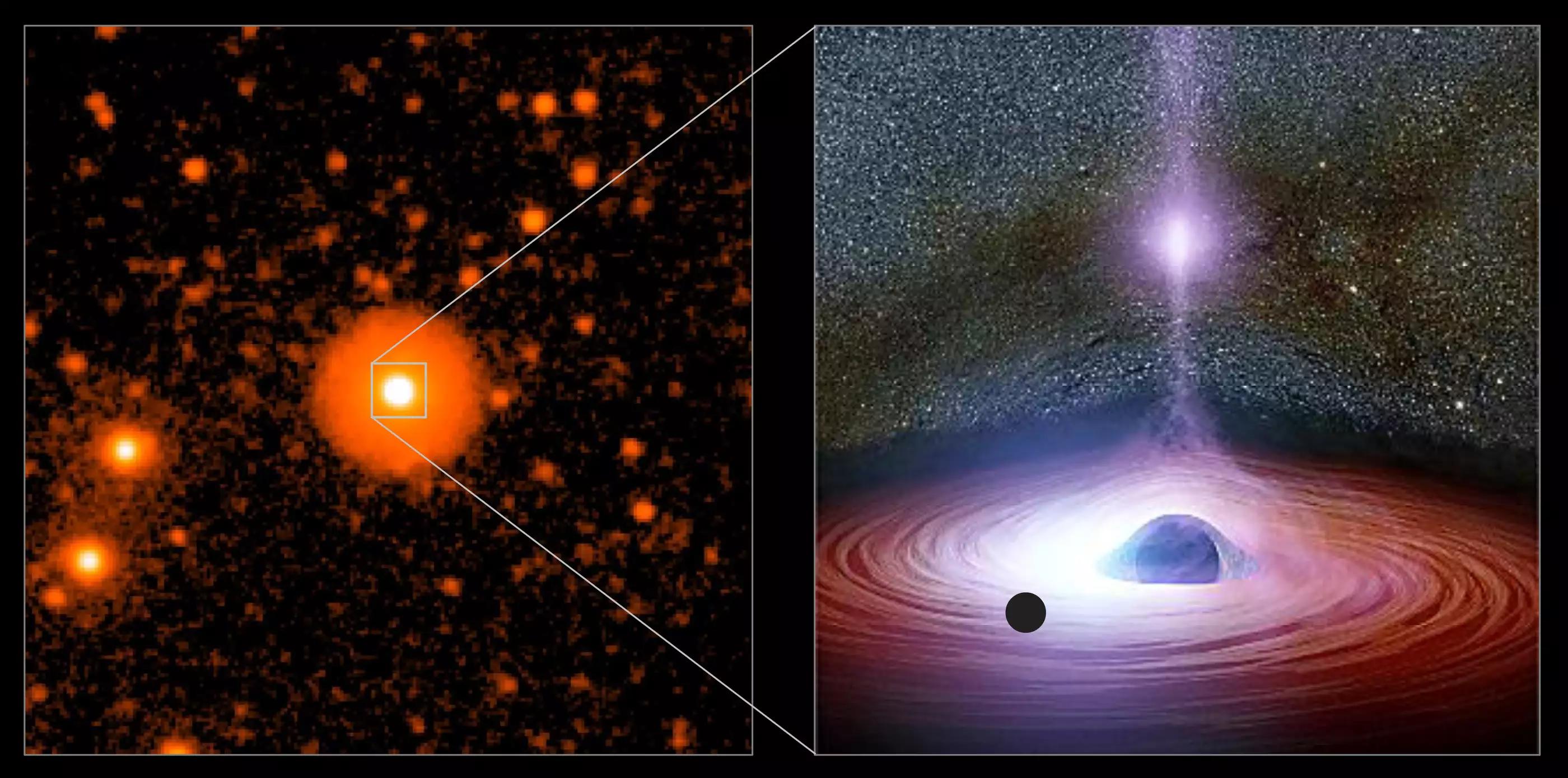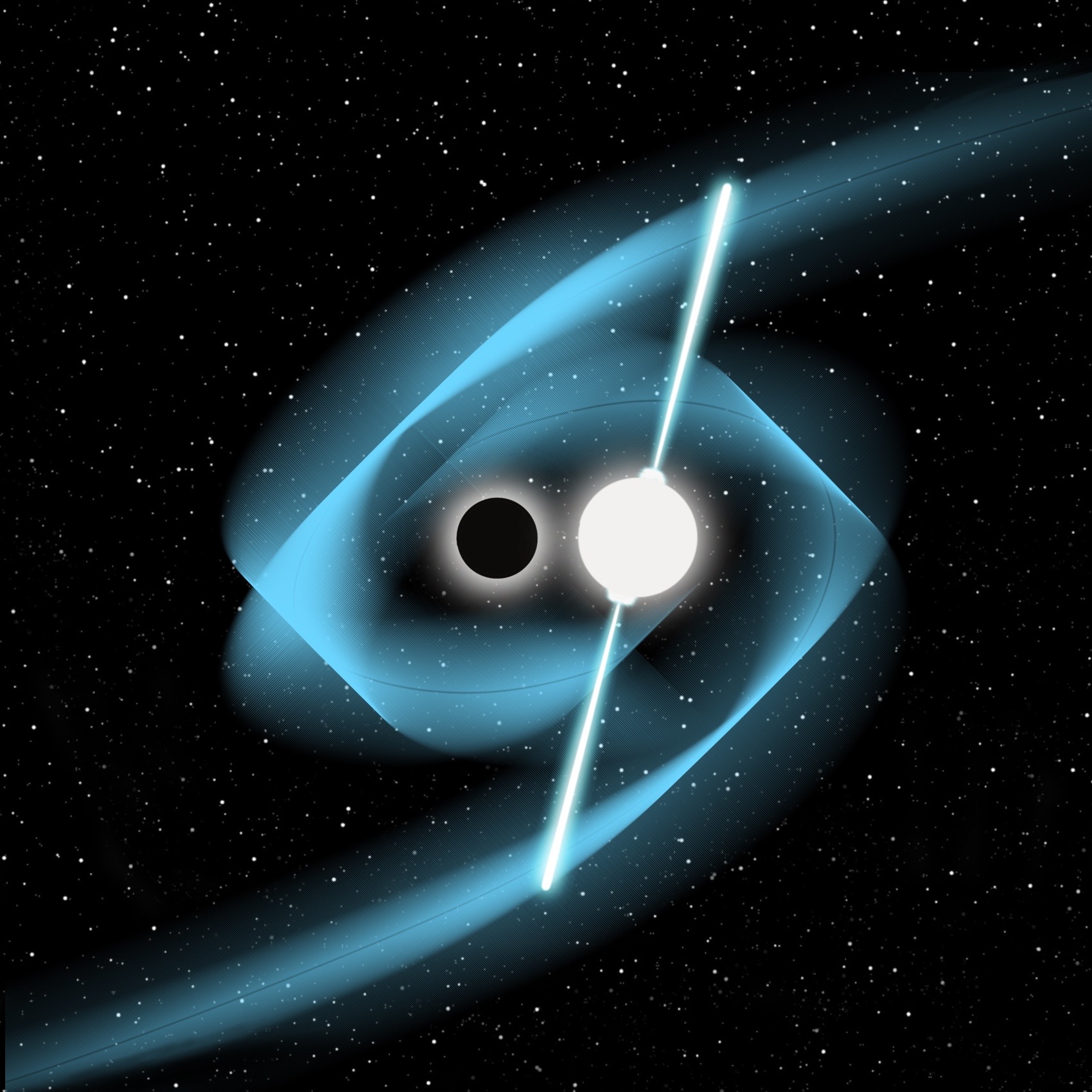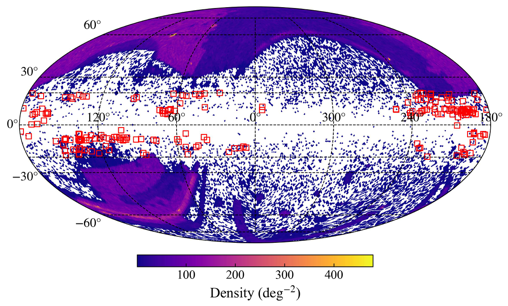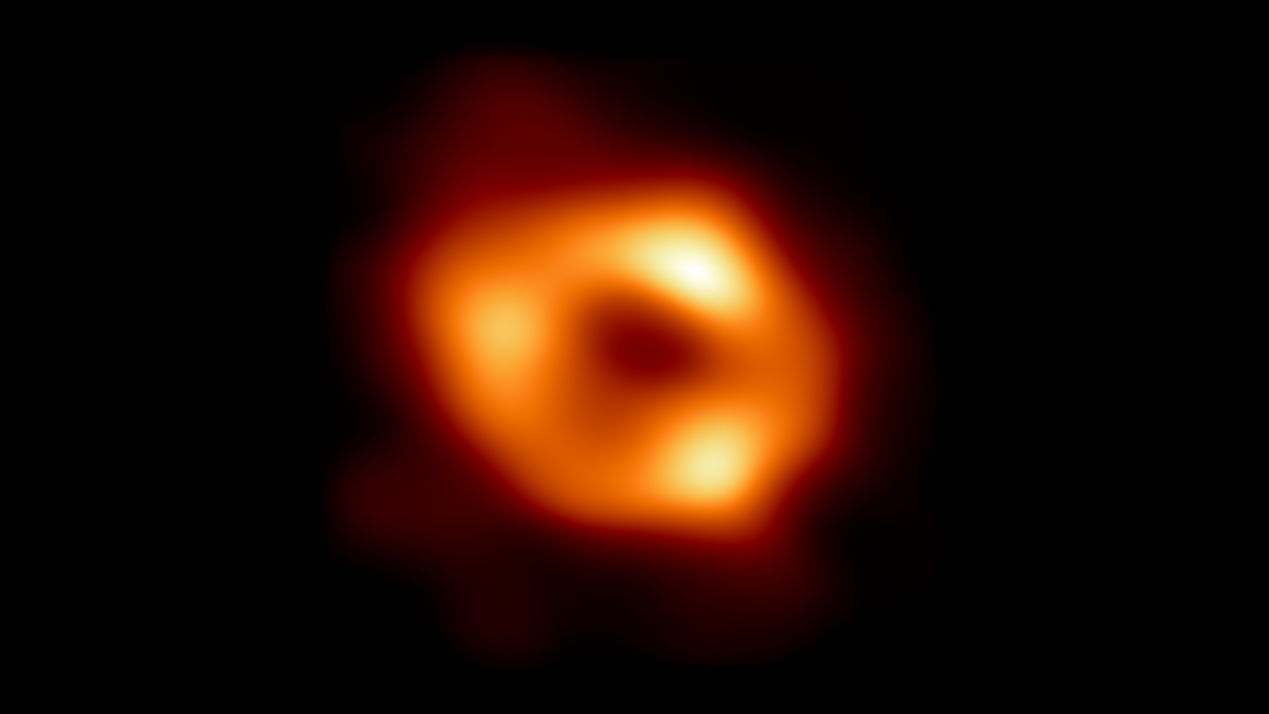 An international research group including Professor Fukun Liu at The Department of Astronomy and The Kavli Institute for Astronomy and Astrophysics of Peking University in Beijing, China, presents important new results on the active galaxy OJ 287, based on the most dense and longest radio-to-high-energy observations to date. The scientists were able to test crucial binary model predictions using multiple observing tools, including the Effelsberg radio telescope and the Neil Gehrels Swift Observatory. The team measured an independent mass of the black hole mass and the mass in the disk that surrounds the black hole.
The results show that an exceptionally massive black hole exceeding 10 billion solar masses is no longer needed. Instead, the results favor models with a smaller mass of 100 million solar masses for the primary black hole, consistent with the results obtained about twenty year ago by Fukun Liu and Xue-Bing Wu, also at Peking University. Several outstanding mysteries, including the apparent absence of the latest big outburst of OJ 287 (which has now been identified) and the much-discussed emission mechanism during the main outbursts, can be solved this way. Independent results on blazar physics that trace processes near the jet launching region were obtained.
The findings are presented in two papers published in MNRAS Letters and the Astrophysical Journal. An international research group including Professor Fukun Liu at The Department of Astronomy and The Kavli Institute for Astronomy and Astrophysics of Peking University in Beijing, China, presents important new results on the active galaxy OJ 287, based on the most dense and longest radio-to-high-energy observations to date. The scientists were able to test crucial binary model predictions using multiple observing tools, including the Effelsberg radio telescope and the Neil Gehrels Swift Observatory. The team measured an independent mass of the black hole mass and the mass in the disk that surrounds the black hole.
The results show that an exceptionally massive black hole exceeding 10 billion solar masses is no longer needed. Instead, the results favor models with a smaller mass of 100 million solar masses for the primary black hole, consistent with the results obtained about twenty year ago by Fukun Liu and Xue-Bing Wu, also at Peking University. Several outstanding mysteries, including the apparent absence of the latest big outburst of OJ 287 (which has now been identified) and the much-discussed emission mechanism during the main outbursts, can be solved this way. Independent results on blazar physics that trace processes near the jet launching region were obtained.
The findings are presented in two papers published in MNRAS Letters and the Astrophysical Journal.
|
 Recently, Peking University PhD student Jinping Zhu, advised by Prof. Zhuo Li, showed that a peculiar class of long-lasting gamma-ray bursts, like GRB 211211, which lack bright supernova counterparts but are associated with candidate kilonova, can indeed originate from black hole-neutron star mergers. Most long-duration gamma-ray bursts (duration longer than about 2 seconds) are typically thought to be derived from core collapses of massive stars, which produce also bright supernovae. Recently, Peking University PhD student Jinping Zhu, advised by Prof. Zhuo Li, showed that a peculiar class of long-lasting gamma-ray bursts, like GRB 211211, which lack bright supernova counterparts but are associated with candidate kilonova, can indeed originate from black hole-neutron star mergers. Most long-duration gamma-ray bursts (duration longer than about 2 seconds) are typically thought to be derived from core collapses of massive stars, which produce also bright supernovae.
|
 In a Nature paper published on 21 September 2022, the FAST FRB team reported using FAST to monitor FRB 20201124A for about 2 months. They analyzed 1,863 bursts of FRB 20201124A detected by FAST in totally 84-hour observations obtained across 54 days, which is the largest sample of bursts recorded with polarization information so far. The high event rate makes FRB 20201124A among the most active known FRBs. They discovered several phenomena never detected before, the irregular short-time variation of the Faraday rotation measure, which probes the line-of-sight magnetic field strength, of individual bursts during the first 36 days, followed by a constant value; they witnessed the quenching of the burst activity on a timescale shorter than three days; they detected prominent circular polarization in these bursts (up to 75%); they detected ooscillations in fractional linear and circular polarizations as well as polarization angle as a function of wavelength. In a Nature paper published on 21 September 2022, the FAST FRB team reported using FAST to monitor FRB 20201124A for about 2 months. They analyzed 1,863 bursts of FRB 20201124A detected by FAST in totally 84-hour observations obtained across 54 days, which is the largest sample of bursts recorded with polarization information so far. The high event rate makes FRB 20201124A among the most active known FRBs. They discovered several phenomena never detected before, the irregular short-time variation of the Faraday rotation measure, which probes the line-of-sight magnetic field strength, of individual bursts during the first 36 days, followed by a constant value; they witnessed the quenching of the burst activity on a timescale shorter than three days; they detected prominent circular polarization in these bursts (up to 75%); they detected ooscillations in fractional linear and circular polarizations as well as polarization angle as a function of wavelength.
|
 An international research team led by astronomers from Peking University has identified 204 quasars behind the Galactic plane, 191 of which are new discoveries, using five optical telescopes in China, USA, and Australia. The new research, recently published in the Astrophysical Journal Supplement Series (ApJS), marks the successful lift-off of the spectroscopic observation campaign, after releasing the candidate catalog of quasars behind the Galactic plane with more than 160,000 sources previously selected by this team. An international research team led by astronomers from Peking University has identified 204 quasars behind the Galactic plane, 191 of which are new discoveries, using five optical telescopes in China, USA, and Australia. The new research, recently published in the Astrophysical Journal Supplement Series (ApJS), marks the successful lift-off of the spectroscopic observation campaign, after releasing the candidate catalog of quasars behind the Galactic plane with more than 160,000 sources previously selected by this team.
|
 A team of astronomers, led by Professor Linhua Jiang at the Kavli Institute for Astronomy and Astrophysics and School of Physics at Peking University, has revealed that distant quasars or galactic nuclei with actively growing supermassive black holes made a negligible contribution of ionizing photons to cosmic reionization 13 billion years ago. This finding settles a long-standing issue about the quasar contribution to cosmic reionization, and suggests that galaxies are the major energy sources. The result was recently published as an article in Nature Astronomy on June 16, 2022. A team of astronomers, led by Professor Linhua Jiang at the Kavli Institute for Astronomy and Astrophysics and School of Physics at Peking University, has revealed that distant quasars or galactic nuclei with actively growing supermassive black holes made a negligible contribution of ionizing photons to cosmic reionization 13 billion years ago. This finding settles a long-standing issue about the quasar contribution to cosmic reionization, and suggests that galaxies are the major energy sources. The result was recently published as an article in Nature Astronomy on June 16, 2022.
|
 Astronomers have unveiled the first image of the supermassive black hole at the centre of our own Milky Way galaxy. This result provides overwhelming evidence that the object is indeed a black hole and yields valuable clues about the workings of such giants, which are thought to reside at the centre of most galaxies. The image was produced by a global research team called the Event Horizon Telescope (EHT) Collaboration, using observations from a worldwide network of radio telescopes. This effort involved three scientists affiliated with Peking University, including the Director and University Chair Professor Luis C. Ho and Assistant Professor Lijing Shao from the Kavli Institute for Astronomy and Astrophysics, and Assistant Professor He Sun from the College of Future Technology. Astronomers have unveiled the first image of the supermassive black hole at the centre of our own Milky Way galaxy. This result provides overwhelming evidence that the object is indeed a black hole and yields valuable clues about the workings of such giants, which are thought to reside at the centre of most galaxies. The image was produced by a global research team called the Event Horizon Telescope (EHT) Collaboration, using observations from a worldwide network of radio telescopes. This effort involved three scientists affiliated with Peking University, including the Director and University Chair Professor Luis C. Ho and Assistant Professor Lijing Shao from the Kavli Institute for Astronomy and Astrophysics, and Assistant Professor He Sun from the College of Future Technology.
|
 An international research group including Professor Fukun Liu at The Department of Astronomy and The Kavli Institute for Astronomy and Astrophysics of Peking University in Beijing, China, presents important new results on the active galaxy OJ 287, based on the most dense and longest radio-to-high-energy observations to date. The scientists were able to test crucial binary model predictions using multiple observing tools, including the Effelsberg radio telescope and the Neil Gehrels Swift Observatory. The team measured an independent mass of the black hole mass and the mass in the disk that surrounds the black hole.
The results show that an exceptionally massive black hole exceeding 10 billion solar masses is no longer needed. Instead, the results favor models with a smaller mass of 100 million solar masses for the primary black hole, consistent with the results obtained about twenty year ago by Fukun Liu and Xue-Bing Wu, also at Peking University. Several outstanding mysteries, including the apparent absence of the latest big outburst of OJ 287 (which has now been identified) and the much-discussed emission mechanism during the main outbursts, can be solved this way. Independent results on blazar physics that trace processes near the jet launching region were obtained.
The findings are presented in two papers published in MNRAS Letters and the Astrophysical Journal.
An international research group including Professor Fukun Liu at The Department of Astronomy and The Kavli Institute for Astronomy and Astrophysics of Peking University in Beijing, China, presents important new results on the active galaxy OJ 287, based on the most dense and longest radio-to-high-energy observations to date. The scientists were able to test crucial binary model predictions using multiple observing tools, including the Effelsberg radio telescope and the Neil Gehrels Swift Observatory. The team measured an independent mass of the black hole mass and the mass in the disk that surrounds the black hole.
The results show that an exceptionally massive black hole exceeding 10 billion solar masses is no longer needed. Instead, the results favor models with a smaller mass of 100 million solar masses for the primary black hole, consistent with the results obtained about twenty year ago by Fukun Liu and Xue-Bing Wu, also at Peking University. Several outstanding mysteries, including the apparent absence of the latest big outburst of OJ 287 (which has now been identified) and the much-discussed emission mechanism during the main outbursts, can be solved this way. Independent results on blazar physics that trace processes near the jet launching region were obtained.
The findings are presented in two papers published in MNRAS Letters and the Astrophysical Journal.
 Recently, Peking University PhD student Jinping Zhu, advised by Prof. Zhuo Li, showed that a peculiar class of long-lasting gamma-ray bursts, like GRB 211211, which lack bright supernova counterparts but are associated with candidate kilonova, can indeed originate from black hole-neutron star mergers. Most long-duration gamma-ray bursts (duration longer than about 2 seconds) are typically thought to be derived from core collapses of massive stars, which produce also bright supernovae.
Recently, Peking University PhD student Jinping Zhu, advised by Prof. Zhuo Li, showed that a peculiar class of long-lasting gamma-ray bursts, like GRB 211211, which lack bright supernova counterparts but are associated with candidate kilonova, can indeed originate from black hole-neutron star mergers. Most long-duration gamma-ray bursts (duration longer than about 2 seconds) are typically thought to be derived from core collapses of massive stars, which produce also bright supernovae.
 In a Nature paper published on 21 September 2022, the FAST FRB team reported using FAST to monitor FRB 20201124A for about 2 months. They analyzed 1,863 bursts of FRB 20201124A detected by FAST in totally 84-hour observations obtained across 54 days, which is the largest sample of bursts recorded with polarization information so far. The high event rate makes FRB 20201124A among the most active known FRBs. They discovered several phenomena never detected before, the irregular short-time variation of the Faraday rotation measure, which probes the line-of-sight magnetic field strength, of individual bursts during the first 36 days, followed by a constant value; they witnessed the quenching of the burst activity on a timescale shorter than three days; they detected prominent circular polarization in these bursts (up to 75%); they detected ooscillations in fractional linear and circular polarizations as well as polarization angle as a function of wavelength.
In a Nature paper published on 21 September 2022, the FAST FRB team reported using FAST to monitor FRB 20201124A for about 2 months. They analyzed 1,863 bursts of FRB 20201124A detected by FAST in totally 84-hour observations obtained across 54 days, which is the largest sample of bursts recorded with polarization information so far. The high event rate makes FRB 20201124A among the most active known FRBs. They discovered several phenomena never detected before, the irregular short-time variation of the Faraday rotation measure, which probes the line-of-sight magnetic field strength, of individual bursts during the first 36 days, followed by a constant value; they witnessed the quenching of the burst activity on a timescale shorter than three days; they detected prominent circular polarization in these bursts (up to 75%); they detected ooscillations in fractional linear and circular polarizations as well as polarization angle as a function of wavelength.
 An international research team led by astronomers from Peking University has identified 204 quasars behind the Galactic plane, 191 of which are new discoveries, using five optical telescopes in China, USA, and Australia. The new research, recently published in the Astrophysical Journal Supplement Series (ApJS), marks the successful lift-off of the spectroscopic observation campaign, after releasing the candidate catalog of quasars behind the Galactic plane with more than 160,000 sources previously selected by this team.
An international research team led by astronomers from Peking University has identified 204 quasars behind the Galactic plane, 191 of which are new discoveries, using five optical telescopes in China, USA, and Australia. The new research, recently published in the Astrophysical Journal Supplement Series (ApJS), marks the successful lift-off of the spectroscopic observation campaign, after releasing the candidate catalog of quasars behind the Galactic plane with more than 160,000 sources previously selected by this team.
 A team of astronomers, led by Professor Linhua Jiang at the Kavli Institute for Astronomy and Astrophysics and School of Physics at Peking University, has revealed that distant quasars or galactic nuclei with actively growing supermassive black holes made a negligible contribution of ionizing photons to cosmic reionization 13 billion years ago. This finding settles a long-standing issue about the quasar contribution to cosmic reionization, and suggests that galaxies are the major energy sources. The result was recently published as an article in Nature Astronomy on June 16, 2022.
A team of astronomers, led by Professor Linhua Jiang at the Kavli Institute for Astronomy and Astrophysics and School of Physics at Peking University, has revealed that distant quasars or galactic nuclei with actively growing supermassive black holes made a negligible contribution of ionizing photons to cosmic reionization 13 billion years ago. This finding settles a long-standing issue about the quasar contribution to cosmic reionization, and suggests that galaxies are the major energy sources. The result was recently published as an article in Nature Astronomy on June 16, 2022.
 Astronomers have unveiled the first image of the supermassive black hole at the centre of our own Milky Way galaxy. This result provides overwhelming evidence that the object is indeed a black hole and yields valuable clues about the workings of such giants, which are thought to reside at the centre of most galaxies. The image was produced by a global research team called the Event Horizon Telescope (EHT) Collaboration, using observations from a worldwide network of radio telescopes. This effort involved three scientists affiliated with Peking University, including the Director and University Chair Professor Luis C. Ho and Assistant Professor Lijing Shao from the Kavli Institute for Astronomy and Astrophysics, and Assistant Professor He Sun from the College of Future Technology.
Astronomers have unveiled the first image of the supermassive black hole at the centre of our own Milky Way galaxy. This result provides overwhelming evidence that the object is indeed a black hole and yields valuable clues about the workings of such giants, which are thought to reside at the centre of most galaxies. The image was produced by a global research team called the Event Horizon Telescope (EHT) Collaboration, using observations from a worldwide network of radio telescopes. This effort involved three scientists affiliated with Peking University, including the Director and University Chair Professor Luis C. Ho and Assistant Professor Lijing Shao from the Kavli Institute for Astronomy and Astrophysics, and Assistant Professor He Sun from the College of Future Technology.
